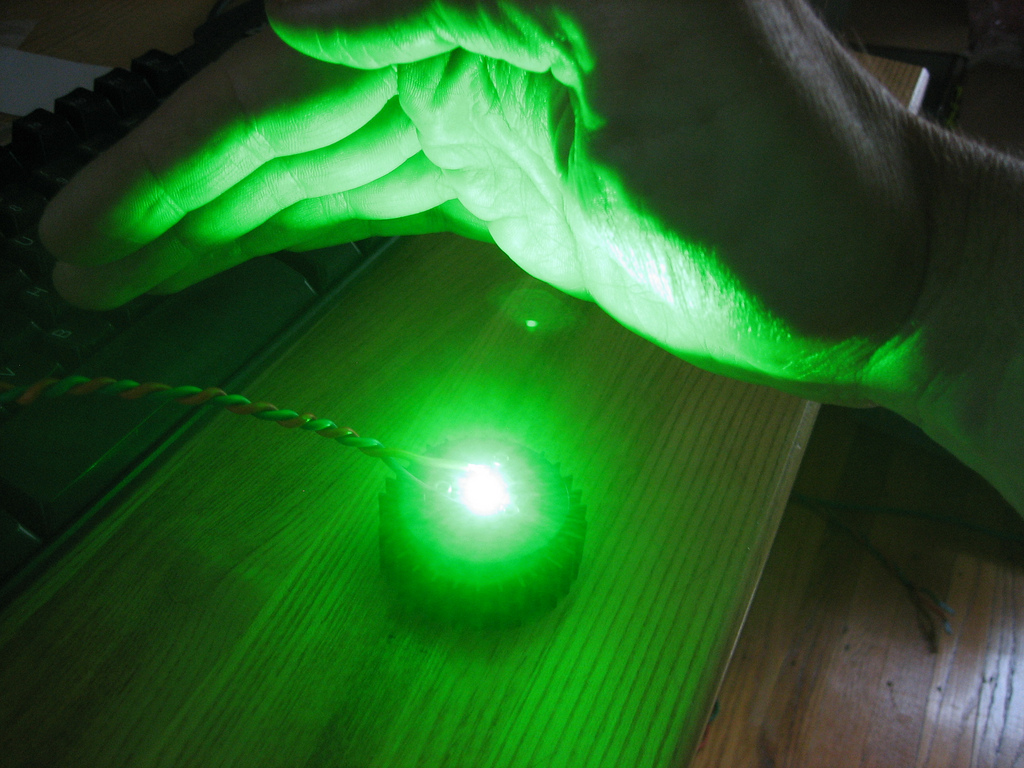Driving high-power LEDs
While waiting for the Rascal to be assembled by robots in Colorado, I designed a small circuit board that plugs into the top of the Rascal for driving high-power LEDs. In the last decade, clever engineers have figured out how to make LEDs that can handle around 100 times the current of the typical LED from the 90's. This is great if you want to make a small, really bright light. Unfortunately, it also means that you get a little more advanced with drive circuitry to avoid your control system burning up when at full power.
My brother is a neuroscientist at the University of Michigan; he spends a lot of time shining lights of various colors onto retinas to try to learn how they work.
Most LED drivers vary the intensity of light by using what's called pulse-width modulation (PWM). The basic concept is that you switch something full on and full off really fast, you can control the average power by changing how long you delay between switches. Suppose you have an LED that can handle 100 mA at full brightness. If you wanted to run it at half brightness with PWM, you might switch it on for 2 milliseconds, and then off for 2 milliseconds. Repeat that 4 millisecond pattern 250 times per second, and the LED will look about half-brightness. If you wanted to go to 25% brightness, you could go to 1 millisecond on and 3 milliseconds off. Microprocessors, like the one found on the Rascal, are good at switching things on and off quickly and precisely.
The only problem is that if you're a retinal neuroscience researcher, you worry that PWM might affect your results in unexpected ways. You already know that light pulses at frequencies of 5-10 Hz cause strange things to happen to retinas. You can't actually see the difference between PWM and linear control with your own eyes, but being a retinal neuroscience researcher, you don't trust your own eyes at all. You'd rather control current directly.
What we were aiming for
After talking over the requirements with my brother for a while, here's what we were aiming for.
- Control LED current using smooth variation in series resistance, not modulated pulses
- Exact LED output needed is unknown, but we think 1000 mA will do it
- Interface with 6-pin connector on QImaging Retiga 1300i camera to trigger camera during brief LED flash
- LED illumination time should be variable from 100 ms to 5 s, accurate to within 10 ms
- We want to be able to handle green, blue, and UV LEDs
The LEDs we're using
We decided to use LEDEngin's LZ1-10xx05 series of 5 W LEDs on pre-fabbed metal-core PCBs
- Green (523 nm): LZ1-10G105, Mouser 897-LZ110G105, $10.80 in qty. 1, 1000 mA, 4.5 V, 165 lm output
- Blue (465 nm): LZ1-10B205, Mouser 897-LZ110B205, $9.90 in qty. 1, 1000 mA, 3.6 V, 45 lm output
- UV (400 nm): LZ1-10UA05, Mouser 897-LZ110UA05, $30.60 in qty. 1, 700 mA, 3.9 V, 130 mW output
- UV (368 nm): LZ1-10U605, Mouser 897-LZ110U605, $46.80 in qty. 1, 700 mA, 4.1 V, 550 mW output
For testing, we got one of the recommended Cooler-Master ECB-00529-01-GP heatsinks, but in the final design, the metal-core PCBs will be mounted to a large aluminum plate that interfaces to the microscope. If need be, we'll add a heatsink to the back of the plate.
Controlling the LEDs
Controlling a 5 W LED is trickier than I expected. My first thought was to use an AD5231 digital potentiometer in series with the LED to control the current. (Ah, the naïveté!) The resistance of the chip ranges from 15 ohms to 10,000 ohms in 9.8 ohm steps. This gives excellent control at low currents, but coarse control as the current increases, because at constant voltage, the current scales with the reciprocal of the resistance.
Really, we needed something that would vary the resistance between around 5 ohms and 50 ohms, and then another series element that acts like a switch. I thought that maybe three of these AD5231's in parallel would work. Running with a 9 V supply, we'd dissipate around 4 V in the LED, leaving 5 V @ 1000 mA in the pots. That's 5 W across the 3 pots, or 1.7 W per pot. At peak power, the current would be split evenly between the three pots at 330 mA each. Unfortunately, the pots fry at 20 mA, so that's not even close.
For the series element acting like a switch, the two major choices are bipolar junction transistors (BJTs) and metal oxide semiconductor field effect transistors (MOSFETs). BJTs can go into thermal runaway when paralleled because their forward voltage drop decreases with as they heat up. This means that a hot transistor pulls more and more current until it burns. MOSFETs have the inverse characteristic-- their forward voltage drop increases as they heat up, so they tend to be self-limiting.
Spelunkers to the rescue!
In the end, we used a circuit based on a circuit designed by a caver in England by the name of Brian Pease. His design is intended for use in a battery-powered headlamp (such as those used in spelunking). It has the cool characteristic that while the battery is healthy, it allows dimming the LEDs. As the battries die, it bypasses the dimmer circuitry and drives the LED at full power, which will presumably be quite dim at this point.
Our circuit uses the same basic design, but with the AD5231 digital pot inserted in place of the manual pot in the original circuit. The PCB we made has three of these circuits so we can control three LEDs at the same time.
We'll have more details when the circuit boards arrive. In the meantime, here's a picture of one of the green LEDs running at around 10% of maximum brightness, controlled by a prototype circuit built on a breadboard.

